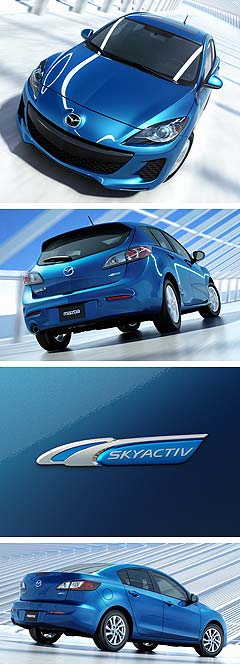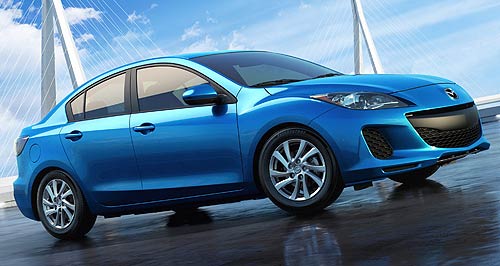Make / Model Search
Future models - Mazda - Mazda3New York show: More Mazda3 SkyActiv detailsMazda3: Mazda's updated small-car will benefit from the brand's new SkyActiv engine tech when it lands here. More power and lower consumption revealed for this year’s upgraded Mazda326 Apr 2011 IT DEBUTED at the Toronto motor show in Canada in February but now the first official details have accompanied the upgraded Mazda3’s North American premiere at the New York motor show last week. Mazda Australia has confirmed the facelifted version of Australia’s top-selling small car so far this year will go on sale here in 2011, but won’t say exactly when and will not comment on technical details. However, Mazda’s extensive US press release provides vital clues about what to expect from the first production model to be equipped with Mazda’s ground-breaking SkyActiv engine technology. While all versions of the 2012 Mazda3 will come with subtle new exterior styling changes – including new headlights, fresh wheel designs and a new front bumper with new-look grille and foglight bezels – only selected North American models will be powered by Mazda’s all-new direct-injection 2.0-litre four-cylinder SkyActiv-G petrol engine with dual sequential valve timing (S-VT). In the US, it will better most of the Mazda3’s small-car rivals and match BMW’s 2.0-litre petrol four by producing 155hp (115kW) at 6000rpm and 148lb-ft of torque (about 200Nm) at 4100rpm. That is about five per cent more peak power and 10 per cent more torque than the current Mazda3’s entry-level MZR 2.0-litre engine, which offers 108kW (at a higher 6500rpm) and 182Nm at a similarly busier 4500rpm. However, North American 2012 Mazda3 models fitted with the new SkyActiv engine will come with a compression ratio of just 12.0:1 – well down on the 14.0:1 compression it was designed to run on with high-quality premium unleaded petrol. Senior Mazda engineers told GoAuto at a preview drive of next-generation SkyActiv technologies in Europe last year that Australian engines would come with 13.0:1 compression due to our lower-octane (91 RON) standard ULP. The Japanese-specification 2.0-litre engine approaches the 122kW power output of the current Mazda3 SP25’s 2.5-litre MZR four (which offers 227Nm), by producing delivers 121kW of power, with 195Nm of torque. So it is possible our SkyActiv-equipped Mazda3 will deliver more than America’s 115kW but less than its 200Nm.  Either way, the 2012 Mazda3’s flatter torque curve should deliver on Mazda’s promise of “higher torque at low and mid-range engine speeds, resulting in better driveability with less fuel consumption in everyday driving”. Either way, the 2012 Mazda3’s flatter torque curve should deliver on Mazda’s promise of “higher torque at low and mid-range engine speeds, resulting in better driveability with less fuel consumption in everyday driving”.Similarly, while Mazda says its SkyActiv-G petrol engines will offer 15 per cent more torque at low to mid-range engine speeds than their current MZR equivalents, it also claims they will be 15 per cent more fuel-efficient. Mazda’s current Three returns 7.9L/100km in base six-speed manual guise and 8.2L/100km with a five-speed auto, while all 2.5-litre models return 8.6L/100km. Matched with its optional new SkyActive-Drive six-speed automatic transmission, Mazda says the US-market 2012 Mazda3 sedan is up to 21 per cent more economical than the five-speed auto model it replaces, with an EPA highway rating of 40mpg (5.88L/100km). The US Mazda3’s city EPA rating of 28mpg (8.4L/100km) is 17 per cent better than before, and even better than the 27/39mpg (8.7/6.0 L/100km) city/highway figures quoted for the 2012 Mazda3 with upgraded SkyActiv-MT six-speed manual transmission. The fuel savings are due mainly to Mazda’s new engine and transmission technologies, but the SkyActiv Mazda3 models also gain aerodynamic improvements including the revised front bumper/grille and larger underbody covers. Seven per cent more slippery than before with an aerodynamic drag coefficient of 0.27Cd (down from 0.31Cd) for the sedan, SkyActiv Mazda3s will also be distinguished from conventional 2.0-litre models by unique headlights, a metallic blue engine cover and blue SkyActiv badging. However, all facelifted 2012 Mazda3 models are expected to come with retuned suspension with revised damping aimed at better ride quality, a stiffer body structure due to extra suspension subframe welds and interior updates like an all-black centre stack with silver highlights and white – rather than red – graphics for the LCD and multi-information displays. The two-year-old BL-series Mazda3’s midlife makeover will also bring a revised electro-hydraulic power assist steering (EHPAS) system, which Mazda says offers improved steering response. In the US, the 2012 will also be available with a new radar-operated Blind Spot Monitoring (BSM) system, as well as an Adaptive Front Lighting System (AFS) with auto-levelling bi-Xenon headlights. As part of Mazda’s drive to reduce its fleet average fuel consumption by 30 per cent between 2008 and 2015, the new SkyActiv petrol and diesel engine range will in coming years be complemented by a new-generation 100kg-lighter platform to underpin third-generation Mazda6 and – on a shortened version – Mazda3 models. Similarly, the next-generation Mazda2 is expected to combine a 1.3-litre SkyAtiv-G engine with another all-new Mazda-designed platform that will again be shared with Ford’s Fiesta. Before then in 2012, however, Mazda’s first all-SkyActiv production model is expected to be the replacement for Mazda’s current CX-7 crossover, as previewed by the stylish Minagi SUV concept that debut at Geneva last month. Further afield, Mazda will add fuel-saving electric technologies like idle-stop, regenerative braking and a petrol-electric hybrid drive system from Toyota to its SkyActiv engines and chassis architectures. The SkyActiv version of the Mazda3 – the Japanese brand’s top-selling US model, accounting for nearly half of all Mazda sales there - joined two other models that achieve 40mph (highway) in New York. Kia and Hyundai showed next-generation versions of their respective one-size-smaller Rio and Accent sedans, both of which will also go on sale in Australia this year.  Read more3rd of March 2011  No Thai take-away for Aussie Mazda3Mazda3 production begins in Thailand and Malaysia, but not for AustraliaAll motor show Alfa Romeo Alfa Romeo Abarth Abarth Alpine Alpine Alpina Alpina Audi Audi Aston Martin Aston Martin BMW BMW Bentley Bentley Chery Chery Brabham Brabham Chrysler Chrysler Chevrolet Chevrolet Cupra Cupra Citroen Citroen DS DS Dodge Dodge Fiat Fiat Ferrari Ferrari Foton Foton Ford Ford Great Wall Great Wall FPV FPV Haval Haval GWM GWM Honda Honda Holden Holden Hummer Hummer HSV HSV Infiniti Infiniti Hyundai Hyundai Jaguar Jaguar Isuzu Isuzu Kia Kia Jeep Jeep Land Rover Land Rover Lamborghini Lamborghini Lexus Lexus LDV LDV Mahindra Mahindra Lotus Lotus Mazda Mazda Maserati Maserati Mercedes-AMG Mercedes-AMG McLaren McLaren MG MG Mercedes-Benz Mercedes-Benz Mitsubishi Mitsubishi Mini Mini Opel Opel Nissan Nissan Peugeot Peugeot Pagani Pagani Proton Proton Porsche Porsche Renault Renault Ram Ram Rover Rover Rolls-Royce Rolls-Royce Skoda Skoda Saab Saab SsangYong SsangYong Smart Smart Suzuki Suzuki Subaru Subaru Toyota Toyota Tesla Tesla Volvo VolvoMotor industry news |
Click to shareAll motor show Alfa Romeo Alfa Romeo Abarth Abarth Alpine Alpine Alpina Alpina Audi Audi Aston Martin Aston Martin BMW BMW Bentley Bentley Chery Chery Brabham Brabham Chrysler Chrysler Chevrolet Chevrolet Cupra Cupra Citroen Citroen DS DS Dodge Dodge Fiat Fiat Ferrari Ferrari Foton Foton Ford Ford Great Wall Great Wall FPV FPV Haval Haval GWM GWM Honda Honda Holden Holden Hummer Hummer HSV HSV Infiniti Infiniti Hyundai Hyundai Jaguar Jaguar Isuzu Isuzu Kia Kia Jeep Jeep Land Rover Land Rover Lamborghini Lamborghini Lexus Lexus LDV LDV Mahindra Mahindra Lotus Lotus Mazda Mazda Maserati Maserati Mercedes-AMG Mercedes-AMG McLaren McLaren MG MG Mercedes-Benz Mercedes-Benz Mitsubishi Mitsubishi Mini Mini Opel Opel Nissan Nissan Peugeot Peugeot Pagani Pagani Proton Proton Porsche Porsche Renault Renault Ram Ram Rover Rover Rolls-Royce Rolls-Royce Skoda Skoda Saab Saab SsangYong SsangYong Smart Smart Suzuki Suzuki Subaru Subaru Toyota Toyota Tesla Tesla Volvo VolvoMotor industry news |











Facebook Twitter Instagram